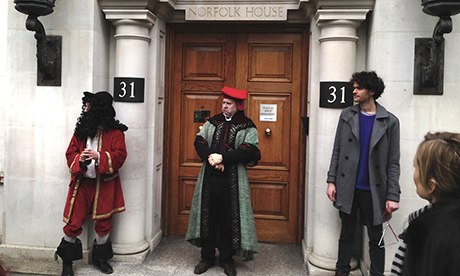
Chocolate is having a moment, and not just because it's Christmas. Last week's Chocolate Festival at the South Bank in London attracted 70,000 punters; British chocolatiers such as Paul A Young and Damian Allsop are big names in foodie circles; and a growing band of high-end "bean-to-bar" producers are creating exotic bars, selling for up to £7 each.
It's no wonder then that Dr Matt Green, the brains behind immersive coffee house tours of London, has turned his attention to chocolate. Green loves a good hot chocolate, but it's the history of the indulgent treat that really interests him. His new Chocolate House Tour is a guided two-hour walk through the grand squares and hidden alleyways of St James's, Piccadilly, accompanied by characters from the past who bring tales from the 17th century to life. I joined a group of about 40 outside St James's church on Jermyn Street. Moments later, Henry Jermyn himself appeared, all glossy long black curls and sweeping red velvet coat, to introduce us to the area he is credited with founding.
It was Jermyn who hired Christopher Wren to build St James's church, and went on to develop St James's Square, which at one point was home to six dukes, seven earls, one prime minister and a mistress. Among the shops and services that popped up to cater to this super elite was a cluster of chocolate houses. In these steamy, smoky, wood-panelled rooms filled with the scent of perfume, noblemen ordered a drink that bore little resemblance to the sweet, milky powdered stuff served in today's coffee chains. The hot chocolate of the 17th century was an extravagant brew infused with citrus peel, jasmine, vanilla, musk and ambegris, as Cosimo de'Medici, a tyrannical Florentine duke and chocolate lover explained to us as we stood in the square.
It wasn't just the brew that was dark and mysterious. The chocolate houses of the 17th and 18th century were dens of iniquity where noblemen plotted the downfall of kings and gambled their fortunes away. One of the first to open, in 1693, was the Cocoa Tree, its interior reminiscent of a Viennese coffee house, its atmosphere more Machiavellian court. When builders drilled down into the foundations, they found a tunnel leading to a tavern in Piccadilly – providing traitors with an escape route. Today the spot is the headquarters of the RAC, an exclusive members' club with rooms and a pool.
From here we made our way to the Crown Passage, once packed with taverns and ale houses. We filed into the Red Lion pub, not for beer but for samples of hot chocolate based on a 1692 recipe of cacao beans, sugar, cinnamon, powdered cloves, and Indian pepper (chilli), and squares of Cocoa Hernando's delicious chilli-infused dark Mexico chocolate, as we learned how chocolate was promoted to the masses as a cure-all for everything from infertility to unattractiveness.
"Nor need the women longer grieve,
Who spend their oil yet not conceive,
For 'tis a help immediate,
If such but lick of Chocolate" reads one verse of the era.
One place that is still going strong is wine merchant Berry Brothers & Rudd, which opened in 1698 supplying coffee and chocolate to local businesses. Our group is too big to go in so we peered through festive windows filled with holly and berries at the wood-panelled tasting room. Behind the shop, in London's smallest public square, we met Hernan Cortes, the Spanish conquistador who many believe introduced chocolate to Europe. In his gruff Spanish accent, he regaled us with tales of his travels to the new world and of chocolate drink mixed with the blood of sacrificial victims.
On that grisly note we continued to JJ Fox, the world's oldest cigar shop where Churchill's orders are on display in a glass cabinet."This is what a chocolate house would have looked and smelt like," said Green, with his characteristic enthusiasm, conjuring an image of houses long gone.
Our final stop is the site of White's Chocolate House, so renowned for its debauched goings on it was dubbed "the most fashionable hell in London" and was immortalised by Hogarth in his Rake's Progress painting, depicting a group so engrossed in gambling they fail to notice the fire blazing in the room. White's later moved to St James's Street and is now the London's oldest gentlemen's club – where Prince Charles had his stag do.
With tastings limited to a swig of hot cocoa and a square of chocolate, Green's tour is not for the chocoholic hoping for free samples, but as an insight into the racy past of one of London's most fashionable neighbourhoods it is fascinating. I came away with a new appreciation of a part of the city I rarely visit. And all for the price of a couple of bars of posh chocolate.
• The next Chocolate House Tours are on 18 January at 2.30pm, and 14 February at 6:30pm. Tours cost £15 per person, unrealcityaudio.co.uk. The Festival of Chocolate takes place in London (11-13 April and 12-14 December), Brighton (29-30 March), Bristol (5-6 April) and Oxford (18-19 April). Tickets £5, tasting ticket £15, under 12s free

